Watering a Lawn

|
Real grass lawns need some watering, even a Cactus plant needs water, but having a great lawn is often assumed to be how much water you have to irrigate it. Basically, is is assumed that if you throw enough water at the lawn, then you will have a great lawn! - Not true. Not only will you run the risk of fungus infections, water logging, souring of soil, but you will also have a gigantic water bill. |

|
See our underground irrigation system "New from America"...
The idea of watering a lawn is to get as much water to the roots of the grass in as efficient manner as possible.
This is important for two reasons 1) The water is immediately available to the grass 2) very little is exposed to the drying effects of the sun. That's why getting the water quickly to at least 6 - 8 inches below the surface should be the first priority. This is exactly what our underground irrigation achieves.
Choose the right type of grass and follow a simple general rule and your problems are further reduced. You must first ask yourself "what am I trying to do? - Ans is:- water enough to get to the roots of the grass, and if you have sandy soil that means watering more frequently and if you have clayey soil watering less frequently, but the general rule is "if you have good deep soil water deep".
As watering tends to wash away nutrients in the soil, it stands to reason that if you only have a couple of inches of sandy topsoil then you should not water as much but more often than if you have 8 - 12 inches of good topsoil.
But however much topsoil you have, the idea is to water your grass to give it an advantage over the weeds.
If in any doubt do it and dig down to see how deep you have watered.
Remember though there are different requirements for different types of lawn grasses.
Phase I - Plugs. water only the plugs with the required amound of water. Seed. Water the seed regularly with a fine spray, to keep the seeds damp until they germinate
Phase II - Seed (once germinated) or Plugs (after about a week or so). This will encourage the grass to grow along the surface.
Phase III - Water infrequently, deep and as and when.
This is one of the cases
where an automatic irrigation system on a timer comes into its own. It
will water the seed at set intervals, thus preventing the seed from
drying out, because grass seed (like any other seed) must not be
allowed to dry out. However working out the frequency of the watering
is not easy. Until now this has had to be trial and error, but now
with our new Watering Gauge
you know exactly when to water your new lawn grass seed, because.... Phase I) So whether you cover
with polythene, geotextil or sow directly on the soil, the seed should
be checked and given a fine mist spray, this could be necessary many
times a day, until the grass seed germinates. And if you have sown pre
germinated seed then the same applies. Keep it damp for at least a
week or until it is clearly rooted and growing. Phase II) When the seedlings are growing and about 1"
high, fertilise and continue to keep damp. You may need to fertilise
again in 3 - 4 weeks. When the seedlings are about 2" high then
watering can be reduced to once per day and the lawn can be given its
first cut. Continue to feed, water, and cut until the lawn is
established. Phase III) When the lawn is established, then water as per
an established lawn.
If it dries out...![]()
Hide this content.
However at this stage you can reduce the watering to once a day, then....
Hide this content.
Nursery grass is only intended to cover the soil and provide you with a lawn until the warm season grass plugs
knit together. You can decide when is the best time to reduce the
watering, depending on the season. If you seeded in March/April ....![]()
Hide this content.
When establishing any grass, it is important to provide irrigation more frequently than normal recommendations call for. If you have planted 12" apart and you wish to speed up the growth, then water every night
(50 - 100 cc of water per plug) for the first 3 to 4 weeks. If you wish to continue the spread
of the warm season grass then continue watering with a spray to
wet the top 1cm of soil,
and feed with our Summer Fertiliser every 2 - 3 weeks, until the
grass plugs connect with each other, and your lawn is complete
and now established.
Remember, by watering manually with a hose spray gun (and only the
plugs) you will save 12 times more water than just letting the
irrigation system water everything.
Phase II By the end of the 3 to 4 week period you can decide on whether you want to keep forcing growth by
watering and feeding. Watering at this stage is to encourage the
stolons to continue to grow outwards and root, so water the lawn once
per day by applying a spray over the whole area to wet the top 1 cm of
soil. If you have planted at 3" intervals this is unnecessary as the plugs
will have connected and you can now reduce watering to,
'as and when for an established lawn'. But whichever method you choose
to water your plugs at this stage, remember for fast results, water,
feed, cut, water, feed. cut, until the lawn is established. Phase III Water as an established
lawn, below.
There are three phases
of watering grass plugs to achieve an established lawn...
![]()

To
the left is 50 cc of water.
More details and watering tips are in our Customised Lawn Repair
Project. ![]()
Hide this content.
Once the turf has been laid, then as a guide it should be watered daily to soak through the turf and into the soil below. The amount of water needed is large and will depend on the underlying soil and the weather conditions, but as an indication, start with 1 - 2 cms of water, this should penetrate the turf.
Use a screwdriver to test the depth of penetration and adjust the frequency (not the amount) of water so that the soil does not dry out.
After 3 - 4 weeks the turf will be established and rooted, and the frequency of watering can be reduced to watering an established lawn.
Hand water bare patches every day to encourage the grass too grow back. If this is done , then warm season grasses will grow back in a few weeks. If you have English Grass then more seed should be sown.
Water when the grass needs it. This can be determined by the colour and texture of the grass and will come quickly with experience.
Automatic irrigation systems are great but not maintained properly can be a real problem.
This is because...... they will water the lawn even if it does not need watering. Water logging the lawn is just as disastrous as not watering enough. So water the lawn depending on the weather conditions and whether the grass actually needs watering. By all means have an irrigation system, (set to automatic if necessary) but be prepared to override it or set it to manual if you feel your lawn does not need watering. You can cause just as many problems with your lawn by over watering as opposed to under watering. Also be prepared to manually water dry spots, where the irrigation system does not adequately water certain areas.
Footnote: "water when it needs it" will
depend on what type of grass you have, the weather in your area, the
temperature, the season, the rainfall, whether the lawn is in
the sun or the shade, the wind, the air humidity, the type of soil,
the composition and compaction of the soil, the height you cut it and
the amount of fertilising it gets. All of these factors is where a
competent gardener proves invaluable.
Hide this content.
When you decide to water, Its best to water really thoroughly than just wet the surface. Down to a few inches at least, in normal soil 6" is best. We have had some crazy comments from lawn owners. "We watered the lawn but it died". This must be a first - watering a lawn makes it die !! |
Fact: Most people have no idea how much water they are using to water their lawn. And in many cases, when asked the question the perception is that they have been watering it a lot, and generally this is complete nonsense and far from accurate. In fact when asked "how much water", peoples estimation is that they are watering their lawn with around TEN TIMES more water than they actually are. |
with deep rooted grasses, this encourages the roots to stay near the surface. Get a really hot day and the roots are killed off. It's much better to water generously (about 1"), once a week to 10 days rather than a little every day.
| Example 1 - Keeping an English lawn alive | Example 2 - Planting drought resistant grasses |
| A common
practice example of watering:
Grassed area 10 x 10 Mtrs (100 Sqm) Frequency: 2.0 Ltr/Sqm, 2 times/day, 7 days/week (assumption is 20-30 min per morning and 20 - 30 min in evening) Calculation: Est. water cost = €0.02/Ltr 100 sqm x 2.0Ltr x 2 times day, 7 days/week x 52 weeks €2,912 per year |
Now plant
one of our medium drought resistant grasses and you get a tremendous cost
saving every year.
Same grassed area 10 x 10 Mtrs (100
Sqm) Frequency: 10 Ltrs/Sqm, ONCE PER WEEK, X 52 * Note) Some of our warm season grasses need less water than this and some need NO watering in the winter. So recalculating: Summer: 10 Ltrs/Sqm, ONCE PER WEEK, X 26 €520 per half year Winter: 10 Ltrs/Sqm, ONCE PER MONTH, X 6 €120 per half year €640 ( ALMOST 5 TIMES LESS !! ) You see in the example to the left, its the "twice a day" and "7 days a week" that cripples your water costs!! Basically a real grass lawn can cost you less money than maintaining your swimming pool and once planted and established will start to save you money! |
Watering on an auto timer schedule does not help in the war on weeds.
Hide this content.
 Tips:
Tips:
1) If you have a good feel for how often your lawn needs watering and it is almost that time and there is a rain shower - maybe a quarter of an inch - that is the BEST time to water your lawn and give it that other 3/4 of an inch. Remember, the grass roots are down deep and most weed roots are near the surface. The idea is to keep the top three inches of soil as dry as you can for as long as you can. That quarter of an inch might make it so that your top three inches is well watered but the lower 9 to 20 inches is on the edge of being pretty dry. This gives the weeds some advantage over your grass!
2) I have discovered that if you are going to water an inch, it is better to water half an inch, wait 90 minutes and then water another half an inch. Maybe do this once a month. Sometimes when the soil gets really dry, it will repel water. This is called
"superdeflocculation". If you put a little water in first, wait, and then put more, the soil is better prepared to take in more water.
Imagine a dry sponge - so dry it is stiff. And another sponge, slightly damp - soft and well wrung out. Now pour a cup of water onto each. The water runs off of the first sponge and all over the table. The water is soaked into the second sponge, not a drop is lost.
Remember: water has a strange and powerful attraction to itself. It would much rather stick to itself than disperse through the soil.
3) Every time you water, you wash away soil nutrients. So the less you
over water, the more fertile your soil!
4) One last point about watering deeply: If your topsoil is only two inches deep, laying down an inch of water is a bad idea. An inch of water is good for watering 12 inches of soil. Further, an inch of water will effectively carry a lot of soil nutrients down deeper. So if your soil is only two inches deep, this rinses away a lot of your soil nutrients! So deep watering should be done only in conjunction with deep soil.
 Tip: You can measure the exact amount of water you are using with our garden
hose, water meter
Tip: You can measure the exact amount of water you are using with our garden
hose, water meter
Hide this content.
The best time to water is when the grass shows signs of wilting, curling, folding or changing colour (depending on the type of grass you have). This is why automatic watering systems are not a good idea. Grass grows depending on the weather, and does not understand automatic irrigation timers. Watering on a schedule also does not help in the war on weeds.
See.....
When to water is generally
accepted as "when the sun goes down". This is wrong and can cause
many problems in certain areas. On sheltered lawns, if there is any chance of fungus
getting established, It is much better to start watering an hour or so
before sunrise.
Warm Season Grasses:
Winter: Warm season grasses go dormant in the winter
so do not need much watering.
Summer: During the summer because warm season grasses
are growing at their fastest and have roots that go down very deep, the frequency of waterings is
greatly reduced. Maybe once a month, maybe once a week to 10 days, but check the
weather conditions and the condition of the grass - it will save you
water.
Cool Season Grasses:
Winter: Cool season grasses grow in the winter and
need watering. Because their roots are shallow, they will only need
enough water to penetrate a few inches of soil. If you are not sure,
push a screwdriver into the soil as a test for water penetration.
Summer: Annual cool season grasses do not survive the
heat of the Mediterranean summer. By May/June a lot are dead. Cool Season
grasses will need large amounts of water in the Summer to keep them alive - watering
once or twice a week is not unusual, and watering twice every day is common in the Mediterranean.
Hide this content.
Real Grass Lawns
Lawns in Spain
Grass Lawns Newsletter



